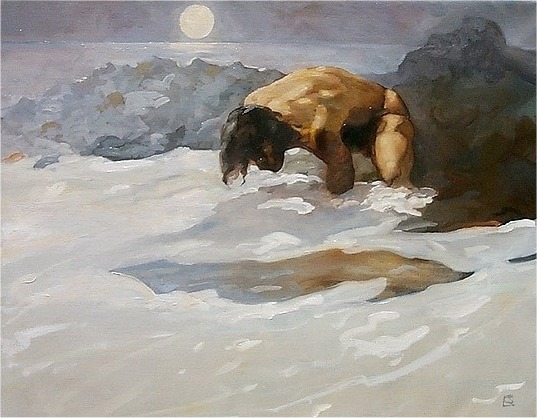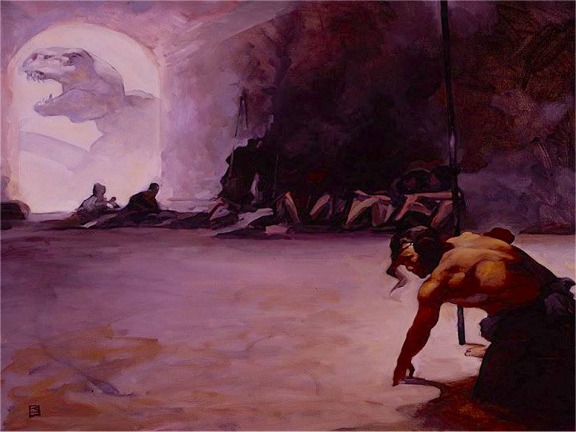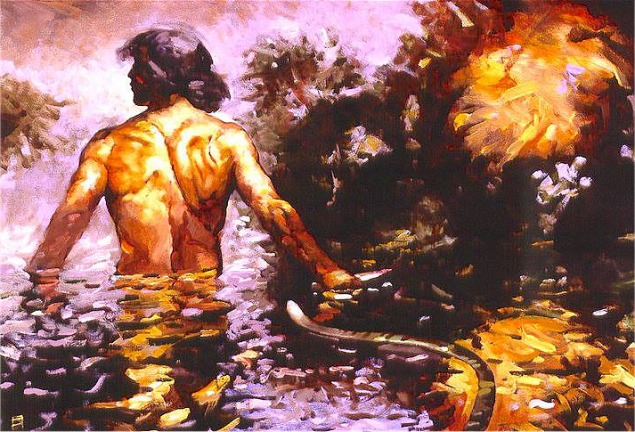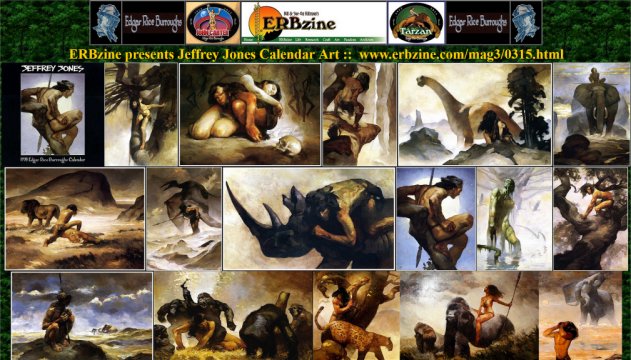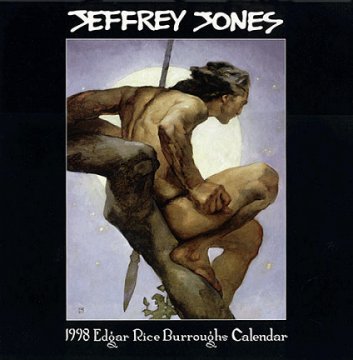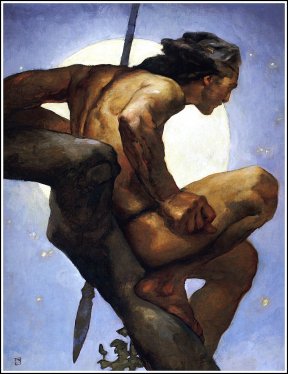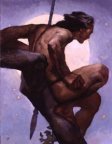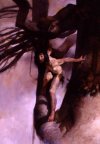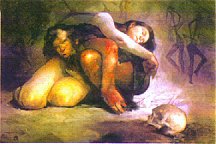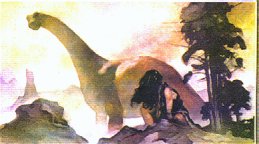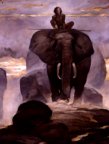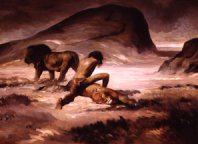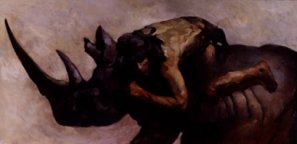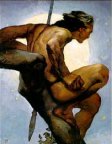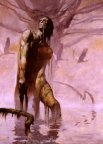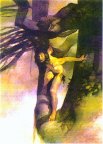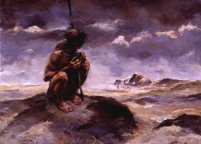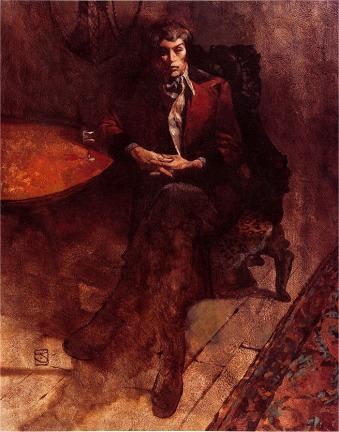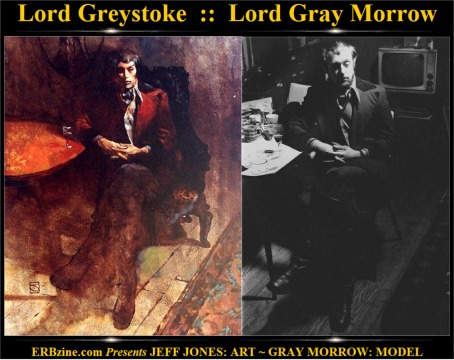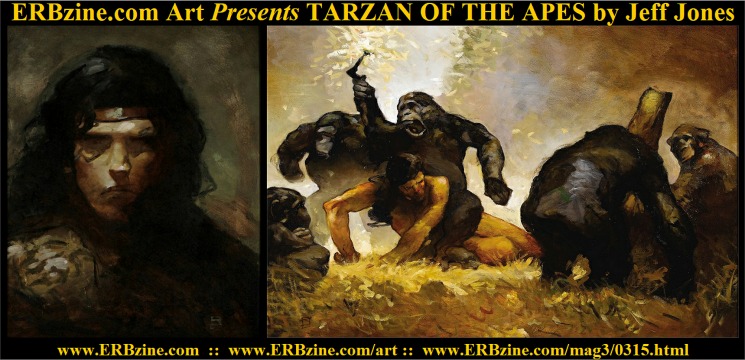This is the ultimate Tarzan painting.
Here Jones obviously echoes the famous Arting silhouette, which remains
one of the finest renditions because of its dark, illusive portrayal so
necessary to grasp Tarzan's true nature. Yet, Jones' vision is so
superior that it nearly erases the power of the original.
Jones' Tarzan so fills the frame that he
overflows in all directions but one, the direction he is facing.
The pose of the legs is similar to Arting, but where Arting's Tarzan is
relaxed and almost effete with his dangling leg and limp wrist on a little
branch barely large enough to bear the weight of his hand, Jones has given
us a block of human power and majesty. Tarzan's thighs have become
Burroughs' mighty thews instead of the skinny pipe stems of Arting.
Arting's little hand on a twig has become
with Jones the fist of a blacksmith connected to forearms that appear to
be strong enough to propel his entire body through the trees. Yet
here is an Apollo rather than a Hercules as Burroughs described him.
The curve of his deep ridged back rests against a curving limb while his
foot is placed solidly against the wood like a man who is familiar with
a life amid the branches.
Arting's moment is one of discovery.
Tarzan peers into the dark jungle for a vision of what is there, and this
is a true picture of the ape-man. He is hunched and feral, yet he
is a man we view with a single human perspective.
Jones' Tarzan is a solid force that lives
between two worlds. His right side with the fist and bent leg may
cause him to leap from the frame at any moment, yet his left side is relaxed
into a pose that causes him to stay. His left arm is relaxed upon
the bough and the stone-tipped spear almost dangles from the finger-tips
we cannot see. The right side is tense and poised to leap.
The left side is nearly at rest. It is indeed a telling psychological
portrait.
Arting's silhouette is seen straight on,
and the revelation of a slight pot belly is a bit disconcerting.
Jones' Tarzan is twisted into a riot of curves that both reflects and becomes
part of the twisted tree. Only the circular moon in the background
holds all of these body lines into a whole that is calming even as they
try to tear themselves from the page. Imagine this picture without
the moon if you can, and you will see what I mean.
The head of Jones' Tarzan is an extension
of the tree limb, so that the line that curves from the tree to Tarzan's
left arm to his solid black mass of hair is all one thing. Tarzan
is truly a man of the trees, his head jutting like a branch, his features
half-hidden.
In my opinion this is the finest portrayal
of Tarzan of the Apes ever made by human hands, and I can't imagine another
coming close to its compelling grace and power.

January
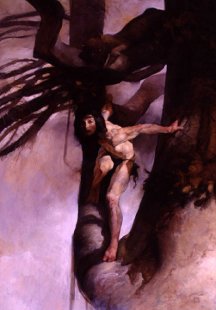
Tarzan of the Apes
Tarzan, the spirit of the woods, comes out
of a yellow fog upon a strangely barren forest bole. Over his head
a black panther extends another limb of the arboreal giant. Tarzan's
body is as contorted as the tree of which he is its most natural growth.
The power of this image is almost overwhelming. Human limbs and tree
limbs are linked in a primitive conjunction. This is a dark forest
god emerging from the depths of the human psyche. Dream-like, he
almost disappears before our eyes like the shadowy beast above. Tarzan
is a denizen of a woods that flies away like a Rackham's witch --
a sprite, god of Caliban, ghost of our nightmares. Tarzan's soul
has never before been captured with such telling force.

February
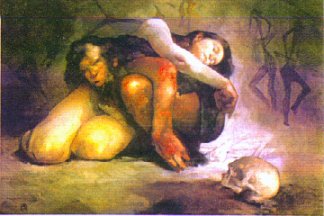
The
Cave Girl
Jones is the painter of stone, and here the
stone-age man and woman are wrapped into a ball of living stone.
She is pale and white, an ample, full-bodied Madonna of the Rocks asleep
across the back of the red man Adam, a bearded troglodyte. They are
in a cave together with strange stick-men painted on the walls. Yet
she is of another race, a modern woman held in thrall by the primal man-thing.
A human skull lies upon the floor of the cave, but it is not gruesome --
just a memento mori of the philosopher's cell. There is no terror here,
but the rest of a woman untwined about the ancient man she loves despite
his ugliness. He is at bay for we have found him at home, and he
too loves her with the blind love hidden behind his blinded eyes.
They sleep peacefully together in the stone cave, a little life rounded
by a dream.

March
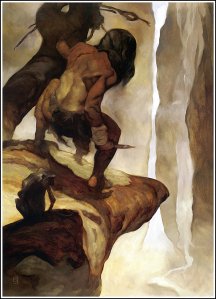
Tarzan
and the Lost Empire
Tarzan and Nkima stand upon a jutting spur
of stone. Before them a gateway. a single slit of light, opens through
this narrow passage they have been traveling together.
Both man and beast are angular pieces of
flesh hung on bone. Tarzan's right arm that holds the tooth of his
knife is bandaged, for he has won through a battle to this point in time,
and now it finally opens into another world. His left arm disappears
into a tree as though he has plunged it there to grasp the strength that
only trees can give him. Tarzan looks ahead into the light, the way
of a man, and Nkima looks the other way, perhaps for something to eat or
drink. They are together, yet separated by their natures. Yet
look again, and you will see that the man is poised like the ape he is
by nature's gift. Look again, and you will know that only the man
can lead the way through the slit of light, through the crack in the stone
that promises an escape from the walls of stone that hold such creatures
in. I have never before seen such a powerful explanation of what
it means to be a human caught in the body of a beast.

April
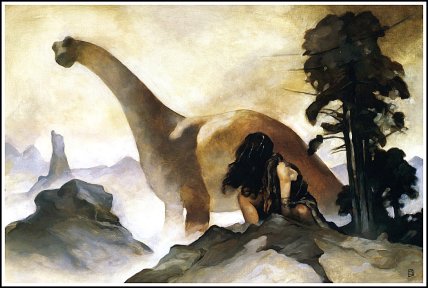
Pellucidar
The giant brontosaurus peers at the crouching
woman. Like all of the paintings in this series it is done in the
warm browns and subtle blue-greens of earth. The beast does not threaten
the woman but remains a pellucid stone of what it is. She bends beneath
the mountain of the beast, interior and watching the monster until it will
finally decide to move away. She is dressed in the aqua marine of
the tree that stands beside her, hair scratched by the quick strokes of
the artist's brush to reveal the same light of the eternal sun, the everlasting
light of the sky. We are nearly blinded by the light coming from
the back of the beast, yet she does not turn away from looking at its passing.
Although the beast stands above her, she
is the stone peak of this little knoll. Even though she is prepared
to spring away, we know she will never do so, but wait until the moment
passes, then roll away like the circling sun of Pellucidar. If she
should turn her face towards us, we would surely be turned to stone as
well.

May
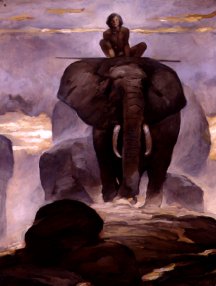
Jungle Tales of
Tarzan
Tarzan rides the great rolling stone of Tantor,
the elephant. All the stones move toward us with inexorable force,
yet the man seems unconcerned that we will be crushed by their coming.
Tarzan's spear is simply a mahout's pole
of guiding placed horizontally with the elephant's ears. He does
not need to direct traffic in this wilderness because they are simply
going from one place to another. The man on the beast is relaxed
when he sees us standing in this barren zone. He seems to be saying,
"Who are you, little thing upon the ground?" He is not in the least
concerned, for he is a man who moves upon a mountain. All the stones
roll forward, and we will soon be covered by the gait of the great grey
clouds and the great grey stones and beast that passes and rolls on unaware
that we have ever been here.

June
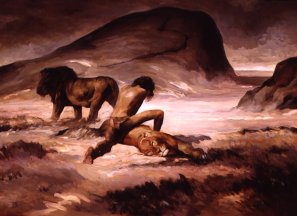
Tarzan
and the Lion Man
Tarzan completely dominates a lioness, who
is lying upon her side, by placing a leg over her body while a large male
lion strides away without a concern. This is such an odd painting
that it makes one wonder at the story scene it must portray. There
is a bestial eroticism to the painting that cannot be gainsayed.
In the upper half of the canvas a gigantic escarpment rises with an S-shaped
path rising to its summit. The sun pours white-hot light into the
valley that illuminates the scene as though Tarzan were performing a sacrifice
upon the dead lioness. It is a masterly work of art, yet very disturbing,
almost occult in its hidden meaning.

July
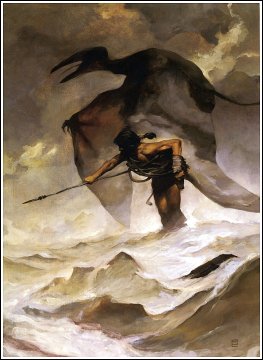
Back
to the Stone Age
A warrior poses, pointing his spear, while
in the background, his spiritual shadow a great, prehistoric pterodactyl
files away through the misty sky. The bottom of the picture, which
takes up nearly half of the painting appears to be a wave-washed shore
in which the man is standing nearly to his knees.
Of all the painting in this collection, this
is the only one that one might mistake for a Frazetta because of the almost
theatrically posed figure. The one give-away that makes this Jones
rather than Frazetta is the oddly contorted stance of the warrior's body.
I do not state this as a negative factor of Jones' work since it is another
of his strengths in portraying the human body, a creature struggling
within its case of flesh against a primitive and dangerous existence upon
this planet.
About the body of the warrior, who stands
as a golden figure between the grey, leathery bird and the foamy white
of the shore, is a rope, loosely wrapped as though he were a mariner guiding
a rescue at sea. The design in this scene is impeccable, which makes
it one of my favorites in the series. Despite its violent action
-- once can almost hear the screams of the monster on the storm mingled
with the crash of the waves - - it is a peaceful, almost hopeful scene
as the man leans forward into the wind, his bound hair blowing straight
back. He seems to be reaching, reaching, reaching with that spear
into a great beyond,
pointing it to the place he longs to be.

August
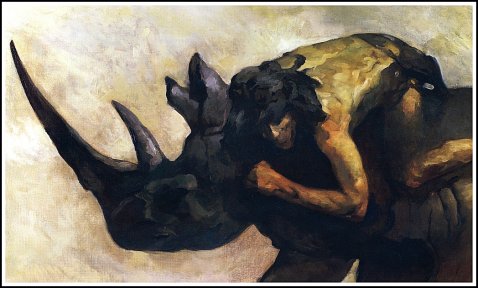
Tarzan
and "The Foreign Legion"
Man and rhinocerous are rolled into a single
creature. The strength of the picture is in the close-up rendering
of the scene. The canvas can barely contain the primitive power of
the horned monster. It is a strong design and very painterly in its
impressionistic application. Jones brushed-in his oils, rough and ready,
befitting the topic. I recommend taking a magnifying glass to this
one to see the subtleties of his work.

September
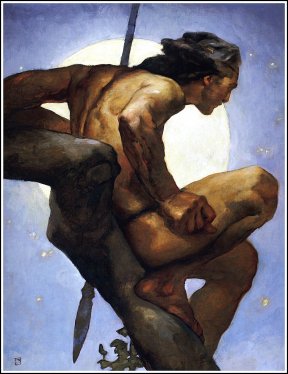
Tarzan
Rescues the Moon
(See cover description
above)

October
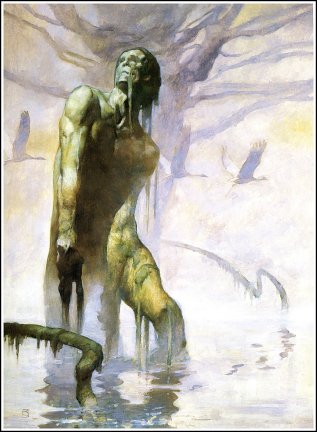
The
Monster Men
A tall, naked man rises from the mud of a
swamp washed in the thinnest of pastels. The eerie phosphorescent
yellow-green of his skin, the mud and slime dripping from his face and
limbs declares him a primal force of nature. Three storks calmly
fly away behind the man -- messengers of a terrible birth slouching forth
-- this Green Man still rooted in the primal ooze to his knees. He
is another root of the tree of life, dimly seen through the mists of time.
His face is the skull-mask we normally wear below the surface. This
body so muscular and lean is a perfect specimen of heroic strength and
grace, but for the twisted leg, which is indeed but a limb of a vegetative
world, echoed three times across the bottom of the painting. It provides
a startling contrast to the golden Tarzans of the set. It is very
Burroughsian though - - a picture of the man underneath the skin of mankind.

November
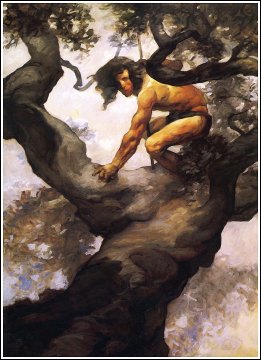
Tarzan,
Lord of the Jungle
Gnarly man Tarzan is a golden branch in a
tangle of gnarly branches. He is a portrait of The Golden Bough.
The tree is the hero in this picture, but as Tarzan is another branch of
this tree, he is also the one, the root of our imagination. Jones has balanced
him well. Tarzan can move quickly either in or out of the frame at
will. It is truly another magnificent Tarzan illustration, worthy
to be placed with the arboreal Tarzans of January and September. Jones
avoided the temptation to allow the tree its golden leaves, thus presenting
Tarzan with the clearest of definition. Both the Ape-Man and the
tree are muscular and bent, although here only the tree partakes of any
distortions. The man is perfect in proportions and intent.
He is the Golden God of the forest.

December
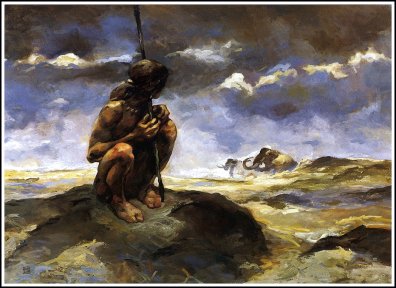
At
the Earth's Core
A naked man sits upon a raised, flat stone,
his head turned to watch two hairy mammoths cross the barren land in the
distance. It is a contemplative scene that says farewell. I
can see the reason Jones placed it at the end of the series. Like
some his other paintings in this calendar, the man is a tightly rounded
form, a stone upon a stone, yet here the figure is more man than myth.
Nothing is twisted or distorted. The clouds that scud across the
sky are filled with light and hope. Nothing is threatened in a world
that passes away.

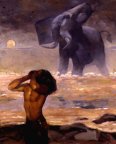
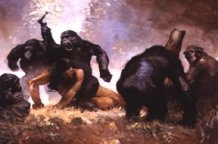
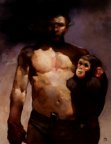
Summary
The work of Jeffrey Jones in this calendar
is surprisingly contemplative and reserved despite the twisted limbs of
his figures. The scenes are painted in the subtle hues of the earth,
and the human figures extend themselves from stone and trees naturally
as though they were a natural part of the things around them, which of
course, they are. His rendition of light leaps from the canvas and
burns our flesh away.
The calendar as a whole is a tour de force
upon natural man. It is much more than a series of Tarzan book covers.
The thing I most enjoy about Jones' work is the fact that it does not have
to be Tarzan or any other creations of ERB we see in his pictures.
Jones is an artist of figures and form in nature, and any literary connotations
we apply to his illustrations are completely unnecessary to their full
appreciation. His paintings stand alone as great works of art, and
we are grateful that we have been allowed to share his magnificent visions.
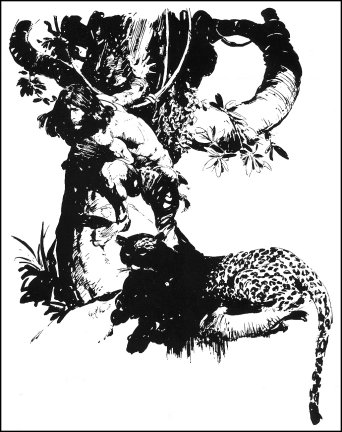
Nkima 2000.02.09

UNUSED CALENDAR ART
